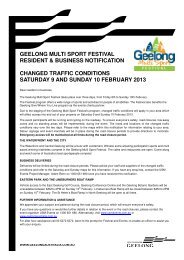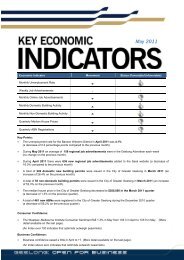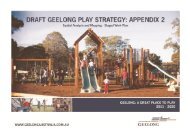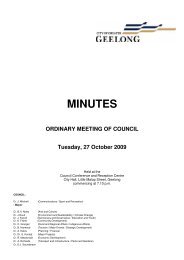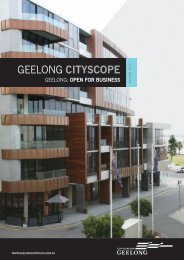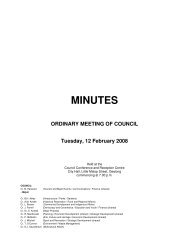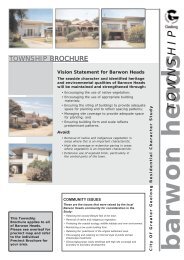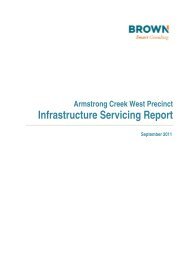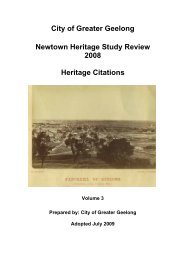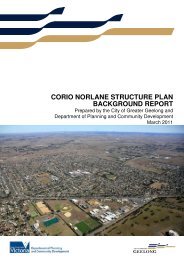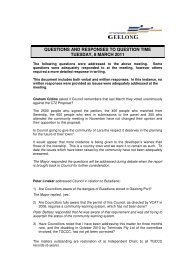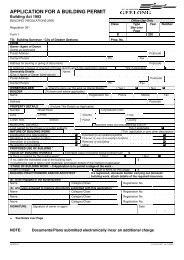CGW Masterplan Review Final Sept11.indd - City of Greater Geelong
CGW Masterplan Review Final Sept11.indd - City of Greater Geelong
CGW Masterplan Review Final Sept11.indd - City of Greater Geelong
Create successful ePaper yourself
Turn your PDF publications into a flip-book with our unique Google optimized e-Paper software.
ackground<br />
This document updates the Waterfront <strong>Geelong</strong> Design and Development<br />
Code 1996 (the Code), a master plan document prepared by Keys Young in<br />
conjunction with the <strong>City</strong> <strong>of</strong> <strong>Greater</strong> <strong>Geelong</strong>.<br />
The Code laid the groundwork for the development that occurred on the<br />
waterfront from 2000 until 2010. During that time most <strong>of</strong> the key sites were<br />
developed and many <strong>of</strong> the improvements to the public realm foreshadowed<br />
in the Code were completed. It is timely to refl ect on past achievements and<br />
remaining opportunities. Following public realm improvements that generally<br />
occured from 1996 to 2000, the precinct experienced rapid growth with the<br />
development <strong>of</strong> privately owned sites from 2000 to 2010. There are a few<br />
development sites still available, as well as various proposals for further<br />
waterfront infrastructure. This review aims to canvass some <strong>of</strong> the remaining<br />
development options in the context <strong>of</strong> the original Code’s design principles<br />
and <strong>of</strong>fers an analysis <strong>of</strong> the changes that fl owed from them.<br />
In addition to the immediate waterfront area, the Code encompassed a small<br />
part <strong>of</strong> the central <strong>Geelong</strong> retail precinct. This review will narrow its scope<br />
by concentrating on the waterfront between Rippleside Park and Limeburners<br />
Point. Work subsequent to the Code has seen the production <strong>of</strong> various<br />
planning documents that specifi cally cover development in the Central<br />
Activities Area and the inner western area <strong>of</strong> the city. These include:<br />
• <strong>Geelong</strong> Western Wedge Framework - 2005<br />
• Central <strong>Geelong</strong>: Looking Forward Structure Plan - 2007<br />
• Central <strong>Geelong</strong> Urban Design Guidelines - 2008<br />
This review <strong>of</strong> the Waterfront <strong>Geelong</strong> Master Plan is premised upon Council's<br />
view that the central waterfront will continue to be managed and developed<br />
as a dynamic recreation destination for residents and visitors. The western<br />
and eastern precincts <strong>of</strong> Corio Bay will continue to be locally focused <strong>of</strong>fering<br />
quieter passive areas, attractive parkland and waterfront spaces, trails and<br />
landscapes.<br />
The Central <strong>Geelong</strong> Waterfront Master Plan 2011 is intended to be appended<br />
as a reference document to the <strong>Greater</strong> <strong>Geelong</strong> Planning Scheme. It will be<br />
referred to by:<br />
• Council <strong>of</strong>fi cers and their consultants when dealing with applications to<br />
develop waterfront property including public spaces;<br />
• Council <strong>of</strong>fi cers and their consultants when modifying or managing<br />
existing public spaces along the waterfront;<br />
• Developers and their consultants and business operators when<br />
considering a development or business proposal.<br />
The redevelopment <strong>of</strong> the <strong>Geelong</strong> waterfront in the 1990s from an industrial<br />
and maritime precinct into one <strong>of</strong> Australia's most vibrant recreational and<br />
tourism waterfront sites, has become the cornerstone <strong>of</strong> the city's economic<br />
revitalisation and a great source <strong>of</strong> community pride.<br />
In 1994, the State Government and the <strong>City</strong> <strong>of</strong> <strong>Greater</strong> <strong>Geelong</strong> funded a<br />
$30 million redevelopment <strong>of</strong> the <strong>Geelong</strong> waterfront. The project, completed<br />
in 2000, has been the catalyst for approximately $350 million in private<br />
investment to date. A further $150 million in private investment is anticipated<br />
by the end <strong>of</strong> 2012.<br />
Set in a new urban landscape based on the city's maritime history and a<br />
contemporary urban culture, the waterfront is the setting for a range <strong>of</strong><br />
restaurants, cafes, hotels, museums and public artworks. Opportunities<br />
to enjoy the outdoors include sites such as the <strong>Geelong</strong> Botanic Gardens,<br />
a range <strong>of</strong> public open spaces, the Baywalk along Corio Bay, pools and<br />
playgrounds as well as countless events and water-based activities.<br />
The waterfront has become the reason why local people to stay in their<br />
own backyard on weekends and holidays, and also the motivating factor for<br />
thousands <strong>of</strong> visitors who journey to <strong>Geelong</strong> each year. Waterfront <strong>Geelong</strong><br />
has assumed iconic status in the marketing <strong>of</strong> the city and now attracts<br />
and plays host to a range <strong>of</strong> local, national and international events. The<br />
waterfront has now proven its potential to generate business investment and<br />
boost tourim expenditure in the region. Visitor numbers have grown to 1.7<br />
million annually and the precinct is now the setting for over 50 public events<br />
each year.<br />
The <strong>City</strong> <strong>of</strong> <strong>Greater</strong> <strong>Geelong</strong> is responsible for much <strong>of</strong> the urban foreshore<br />
area as well as adjacent areas <strong>of</strong> public open space. In accordance with<br />
the Crown Land (Reserves) Act 1978, the Department <strong>of</strong> Sustainability and<br />
Environment has delegated the management <strong>of</strong> waterfront Crown land to the<br />
<strong>City</strong> <strong>of</strong> <strong>Greater</strong> <strong>Geelong</strong>.<br />
The <strong>Geelong</strong> Lands (Steampacket Place) Act 1996 also allows for Crown land<br />
in the precinct be capable <strong>of</strong> being leased for longer periods and for different<br />
purposes from those set out in the Land Act 1958 and the Crown Land<br />
(Reserves) Act 1978.<br />
Additionally the <strong>City</strong> administers the the <strong>Greater</strong> <strong>Geelong</strong> Planning Scheme<br />
and is owner and manager <strong>of</strong> other public coastal land and facilities including<br />
roads, boat ramps and drainage infrastructure.<br />
Given the high level <strong>of</strong> use and the harsh nature <strong>of</strong> the coastal setting, the<br />
infrastructure, buildings, fi xtures and landscapes along the waterfront area<br />
need to be robust and well maintained.<br />
The <strong>City</strong> <strong>of</strong> <strong>Greater</strong> <strong>Geelong</strong> is committed to the continual improvement <strong>of</strong> Waterfront <strong>Geelong</strong>.<br />
This document seeks to guide that process in the interests <strong>of</strong> the people <strong>of</strong> <strong>Geelong</strong>.<br />
CENTRAL GEELONG WATERFRONT MASTERPLAN 2011<br />
7<br />
Urban Initiatives



